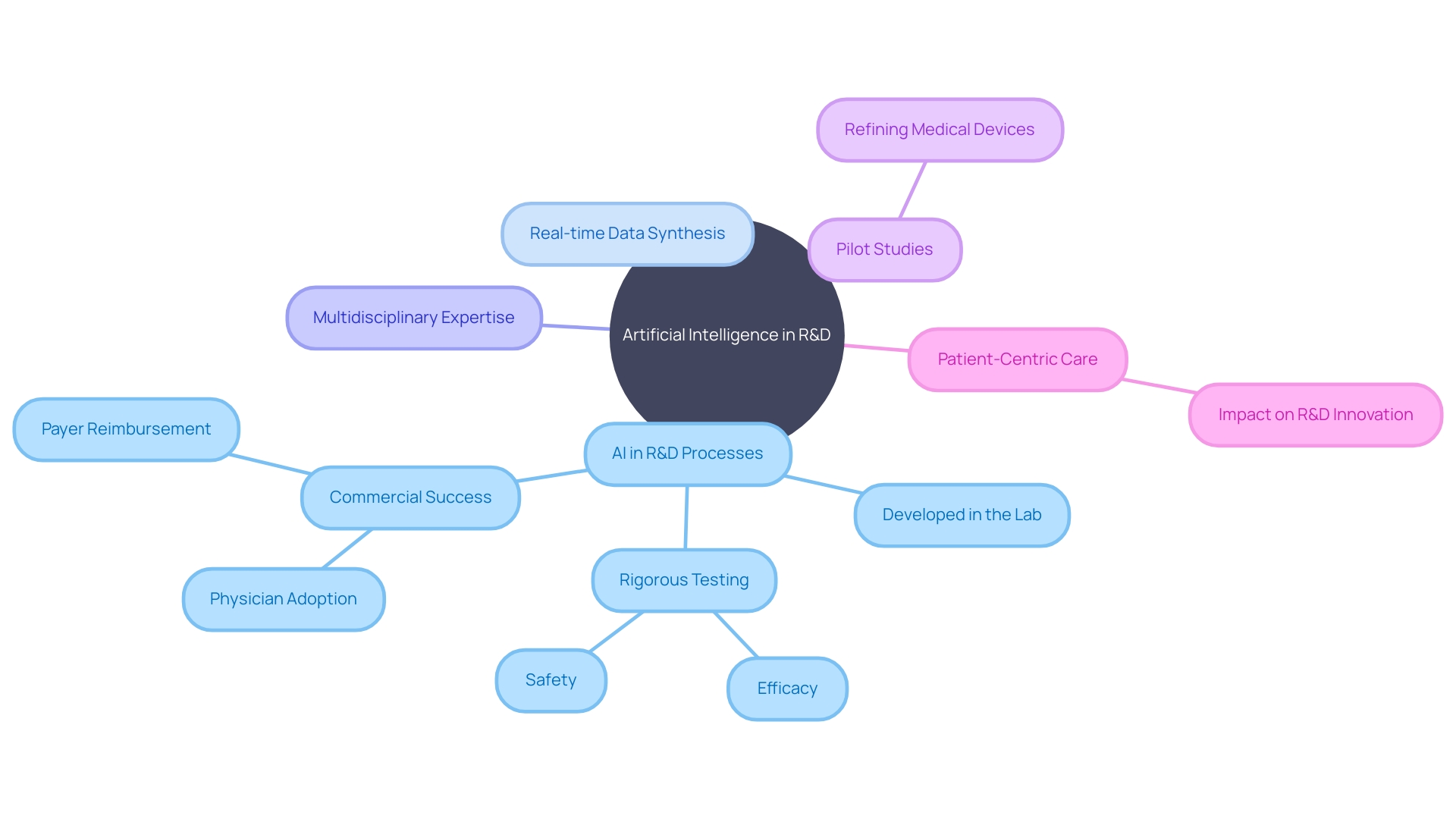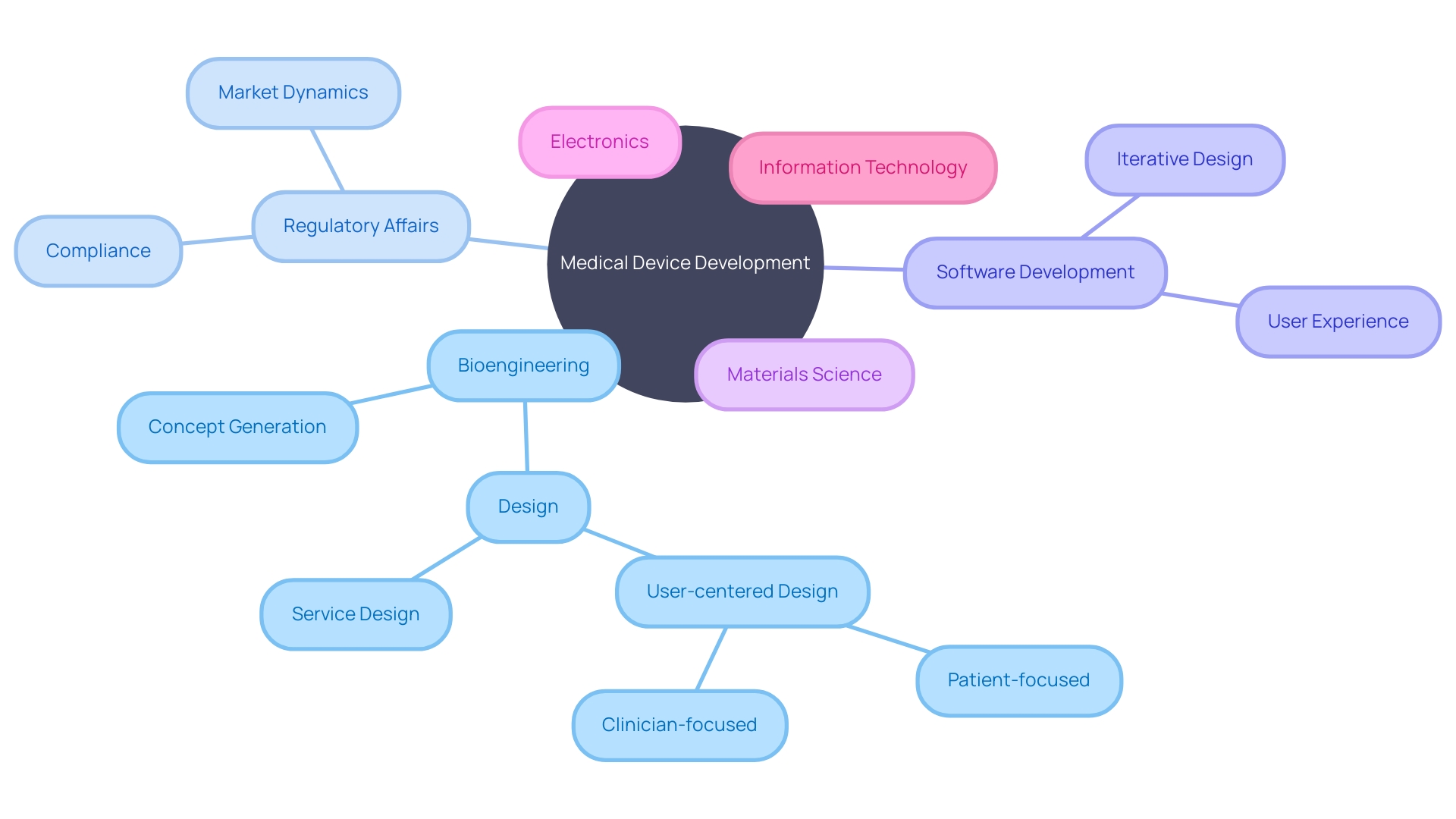Introduction
The Importance of Innovative Approaches in Medical Device R&D
The medical device industry is rapidly growing, with revenue projected to reach $215.80bn by 2024. In this landscape, innovative research and development (R&D) processes are crucial for staying competitive. One key innovation is the integration of artificial intelligence (AI) into traditional R&D approaches.
AI-powered predictive algorithms, for example, analyze real-time data from electronic health records, vital signs, and lab results to assess the risk of patient health deterioration every 15 minutes. This not only enhances communication channels but also fosters a more resilient healthcare system. Furthermore, the diversity of medical devices, ranging from basic spectacles to advanced MRI machines, highlights the need for multidisciplinary expertise in development.
Engaging a comprehensive medical device development partner is crucial for seamlessly transitioning from concept to market launch and optimizing costs. Pilot studies also play an indispensable role in managing risks, conserving resources, and accelerating the overall R&D process. With over 10,000 device types identified by the World Health Organization, each pilot study can lead to groundbreaking advancements in medical device R&D and shape patient-centered care.
The Importance of Innovative Approaches in Medical Device R&D
As the medical device industry propels towards $215.80bn in revenue by 2024, innovating R&D processes becomes pivotal. One key innovation is employing artificial intelligence (AI) to augment traditional R&D approaches.
An exemplary case of Ai's impact is a predictive algorithm that synthesizes real-time data from electronic health records, vital signs, and lab results. Approximately every 15 minutes, it assesses the risk of patient health deterioration, enhancing communication channels and fostering a more resilient healthcare system.
This utilization of AI encourages medical device developers to navigate complex data, discern patterns, and formulate more tailored and impactful medical solutions. Moreover, diversity in medical devices—ranging from spectacles to advanced MRI machines—necessitates varied technologies in development, highlighting the need for multidisciplinary expertise.
Recognizing device and human factors diversity implies embracing a gamut of sciences, from bioengineering to information technology. In this milieu, engaging a medical device development partner with a comprehensive service array, robust regulatory knowledge, and market intuition is crucial.
The ability to seamlessly transition from concept to market launch not only optimizes costs but also enhances the project's success trajectory. To complement these innovative approaches, pilot studies play an indispensable role. Small-scale testing of new medical devices prior to extensive trials allows for critical assessments and refinements. This not only manages risks but also conserves resources and accelerates the overall R&D endeavor. With over 10,000 device types identified by the World Health Organization, each pilot study could be a step towards groundbreaking advancements, enriching medical device R&D and shaping the contours of patient-centric care.

Case Study: Successful Implementation of AI in Medical Device Development
The integration of artificial intelligence (AI) into medical device development has propelled the creation of sophisticated wearables, such as a smart device for continuous patient monitoring. This tool employs a groundbreaking algorithm that crunches data from vital signs, electronic health records, and lab results in near-real time. The Ai's predictive model analyzes this data approximately every 15 minutes to forecast potential health deteriorations, allowing for the computation of a risk score that signifies the likelihood of patient decline.
When the risk score reaches a critical level, it prompts an alert to the care team. Key figures, including Lisa Shieh, MD, PhD, a clinical professor of medicine, highlight the system's ability to foster strong communication channels within a hospital setting, transforming it into a more resilient health system. Taking a multifaceted approach, teams of researchers and healthcare professionals work collaboratively to refine and execute these AI-powered medical devices.
As they parallel the journey of new drugs — from lab conception to post-market surveillance — their success hinges on rigorous testing and acceptance by healthcare practitioners and payers alike, not just technological innovation. Reports by GlobalData emphasize that, over the next 12 to 24 months, AI in medical will follow trends that span technological advances, macroeconomics, regulation, and industry-specific developments. The intricate process from inception to implementation demands not just a consideration of such trends but also a thorough understanding of the regulatory landscape to ensure compliance and effective adoption.
Benefits of Collaborative Research in Medical Device Development
In the rapidly evolving medical device industry, collaborative research paves the way for cutting-edge innovations that seamlessly blend user-centered design with technical prowess. The exchange of knowledge generated from diverse perspectives enriches the bedrock of medical device development, effectively addressing the intricate needs of all users involved–from patients to clinicians and hospital support staff. Cross-pollination of ideas emerges not merely as a boon for creativity but also as a strategic initiative that mitigates barriers to progress in the intricate healthcare ecosystem.
Moreover, sharing resources during the R&D process can lead to significant cost efficiencies and a streamlined pathway towards the development of new medical devices. Strategic partnerships not only optimize the use of existing infrastructure but also foster cost-effective approaches that can revolutionize the speed at which innovative products reach the market. The fiscal prudence derived from such collaborative efforts empowers organizations to reinvest in holistic R&D, which is paramount to the lifecycle of medical devices that spans from inception to implementation in clinical settings.
The credibility and trust established through these joint endeavors further bolster the reputation of the end products. With the rigorous scrutiny from regulatory authorities like the FDA, which classifies medical devices into categories based on risk level, and the EMA's involvement in Europe, the combined expertise garnered in partnerships enhances the likelihood of swift regulatory approvals. This collaborative tapestry not only enables the harmonization with complex regulatory landscapes but also expedites the commercialization of potentially life-saving medical technologies.
As stipulated by the FDA, approximately 10% of medical devices, including pivotal Class III devices like pacemakers, undergo extensive regulatory processes due to their critical role in patient care. Consequently, the enhanced credibility resulting from collaborative research is instrumental for navigating the approval process for such high-risk devices with longer approval times. Standing at the crossroads of medical advancement and patient-centric solutions, the interplay between user-centered design and strategic research partnerships holds the key to fostering a medical device ecosystem that is both innovative and attuned to the needs of the broader healthcare community.
Regulatory Frameworks for Medical Device Development
Regulatory compliance is a vital aspect of medical device development, with a significant impact on time to market and overall success. The fluctuating landscape of medical device regulations requires close monitoring as global authorities, such as the US FDA and EMA, frequently adjust policies in response to novel technological breakthroughs.
These devices range from simple instruments to complex integrated systems that necessitate scrutiny for patient safety and efficacy. To navigate this shifting terrain, companies must leverage a keen understanding of these evolving frameworks tailored to their product's scale, whether it has a localized distribution or a global presence.
The intricacies of each market's regulatory territory, be it confined to specific continents, nations, or states, demand a strategic approach to compliance, often compelling businesses to choose a universal standard of regulation adherence. Concurrently, the development process intertwines with multiple disciplines—affecting electrical and mechanical elements or software interfaces—meaning optical systems must be considered a holistic challenge, spanning beyond individual domain issues.
Practically, the cleanliness of optical systems depends heavily on the environment, device stage, and application, necessitating an adaptable compliance strategy reflecting these varying stages of development. Of particular note, the FDA categorizes devices into a three-tier system based on associated risk levels, with class three devices, vital to life-support, facing the most stringent evaluations. Approximately only 10% of devices fall under this high-risk stratum, indicative of the minute but crucial segment that could experience protracted approval timescales. The complexity of these regulations is reflected in policies like the OECD's 'Conflict Minerals' guidance, underlining the significance of verifiable and responsible sourcing within the supply chain. In this dynamic regulatory ecosystem, embracing expertise in the field, be it in-house or through strategic partnerships, emerges as a pivotal factor in fine-tuning devices to meet high safety standards and achieve prompt market entry.
Challenges and Opportunities in Medical Device R&D
In the quest to actualize groundbreaking medical technologies, companies face an array of complex hurdles. Interdisciplinary expertise is crucial as the sophistication of medical devices escalates, necessitating collaboration between specialists in diverse realms such as bioengineering, Regulatory Affairs, and software development. This multiplicity of skills mirrors the array presented by the global expanse of medical devices themselves, as cited by the World Health Organization, more than 10,000 distinct types.
Medical device development transcends traditional boundaries, combining materials science, electronics, and information technology. For instance, optics in medical devices is not an isolated field; it intersects deeply with electrical and mechanical engineering, requiring system-wide optimization. Thus, each medical device is a holistic system, intrinsically linked with human factors, and demands a system problem-solving approach.
An effective strategy begins with meticulous research design, guided by a robust question that defines both the independent variables and the anticipated outcomes, as Dr. Thomas Fogarty emphasized. These controlled studies should minimize biases through careful selection of control groups to uphold the integrity of the resulting conclusions. Beyond the confines of R&D, medical device commercialization enters the fray, encompassing gap analysis, strategic supply chain planning, and definitive regulatory pathway identification.
For this phase, embracing commercialization early is paramount, with a clear-eyed focus on the destination—meeting the multifaceted needs of the healthcare ecosystem and proving the invention's worth to stakeholders. Statistically, the landscape is daunting—class three medical devices, for example, undergo rigorous scrutiny due to their high-risk profiles, comprising about 10% of devices the FDA oversees. Nevertheless, companies with a history of successful launches exemplify the capability to navigate the intricate journey from concept to market, a testament to their holistic integration of software and hardware, essential in the digital health domain.

Conclusion
In conclusion, innovative approaches in medical device R&D are essential for the industry's growth and competitiveness. AI integration enhances communication and resilience in healthcare.
Engaging comprehensive development partners and conducting pilot studies manage risks and optimize costs. Collaborative research and strategic partnerships drive cutting-edge innovations and cost efficiencies.
Regulatory compliance ensures success in the market. Challenges include interdisciplinary expertise and holistic optimization. Companies that effectively integrate software and hardware can navigate the complex journey from concept to market. By embracing these approaches, the medical device industry can revolutionize patient care and shape the future of healthcare.




